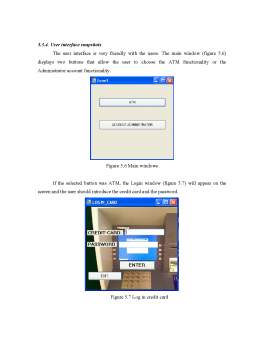Cuprins
- Table of Contents
- 1. INTRODUCTION 5
- 1.1. SUBJECT 5
- 1.2. SHORT DESCRIPTION 5
- 1.3. ABSTRACT 5
- 1.4. SOFTWARE COMPONENT 7
- 1.4.1. What is a software component 7
- 1.4.2. What is a component 7
- 1.4.3. Software component definitions 8
- 1.4.4. Hardware component and software component 8
- 2. INTERFACES 11
- 2.1. DIRECT AND INDIRECT INTERFACES 11
- 2.2. INTERFACES IN CORBA 14
- 2.3. INTERFACES IN JAVA 17
- 2.4. INTERFACES IN MICROSOFT .NET 20
- 3. OBJECT MODELING 24
- 3.1. CLASS NORMALIZATION 24
- 3.1.1. 1ONF 24
- 3.1.2. 2ONF 25
- 3.1.3. 3ONF 26
- 3.2. ORM 27
- 3.2.1. Definition of ORM 27
- 3.2.2. Generic ORM problems 29
- 3.2.3. Benefits of ORM 31
- 3.3. OBJECT AND COMPONENT CLASS 33
- 4. BUSINESS PROCESSES 37
- 4.1. BUSINESS PROCESS AND PROCESS CHARTS 37
- 4.2. CONVENTIONS 40
- 4.2.1 Convention 40
- 4.2.2 Choosing the right words 41
- 4.2.3 Gathering the Facts 42
- 4.3. EXAMPLE: CREDIT CARD PAY AT THE COUNTER PROCESS 43
- 5. APPLICATION 46
- 5.1. PROBLEM DEFINITION 46
- 5.1.1. Problem definition 46
- 5.1.2 Requirement specification 46
- 5.2 ANALYSIS 47
- 5.2.1. Use cases 47
- 5.2.2 Static model 50
- 5.3. DESIGN 51
- 5.3.1. Architecture 51
- 5.3.2. Database design 51
- 5.3.3. Detailed class diagram 55
- 5.3.4. User interface snapshots 56
- 5.4 IMPLEMENTATION 68
- 5.4.1 Installation 68
- 5.4.2 Testing 68
Extras din disertație
1. Introduction
1.1. Subject
…. Direct and indirect interfaces versus software components
1.2. Short description
My paper is compounded of five chapters. The first chapter is an Introduction and it includes the subchapter “Software components”. The second chapter refers to “Interfaces” and it includes three subchapters. “Direct and direct interfaces” is the subchapter where I define what a direct interface and an indirect interface are. The second subchapter is called “Interfaces in Corba”, the third subchapter is “Interfaces in .Net” and the last subchapter is about “Interfaces in Java”.
The third subchapter is about “Object modeling” and consists of three subchapters:
“Class normalization”, “Object relational mapping” and “Object and component class”. The fourth chapter is about the “Business process” and it includes the subchapters: “Business process and process charts”, “Conventions” and “Example”.
The last chapter explains my application. It includes a class diagram, a database diagram, test cases, user interfaces and the implementation.
1.3. Abstract
Component-oriented programming (COP) enables programs to be constructed from rebuilt software components which are reusable, self-contained blocks of computer codes.
In Chapter one of my paper, I included four subchapters about software components where I briefly explain what a component is. After that I included a subchapter about what software components are, followed by a definition of software components. Finally, I provide a short description of software and hardware components.
Component Oriented Programming supports multiple interfaces and interface-oriented design, while Object Oriented Programming does not provide a clear relationship of interfaces among super classes and subclasses.
Interfaces are the means by which components connect. Technically, an interface is a set of named operations that can be invoked by clients. In Chapter two of my paper I briefly describe direct and indirect interfaces, and in order to illustrate them, I offer an appropiate example. In the next subchapters from Chapter two I describe how interfaces are used in Corba, .Net and Java languages.
The second chapter called ”Object modeling” is divided into three subchapters. In the first subchapter, ”Class normalization”, I explain the third normal form for class normalization (specific to agile modelling), 1ONF, 2ONF, 3ONF and offer an exemple. I start with a diagram whose class is not normalized, and I obtain a diagram with all the classes normalized. In the second subchapter, ”Object relational mapping”, I describe the four levels that are necessary for a good ORM solution: pure relational, light object mapping, medium object mapping and full object mapping. The third subchapter, called ”Object and component class”, shows that an object-oriented application is made up of objects and their collaborations. A component-based application is made up of components and their collaborations when a component is the host for the implementation of one or more interfaces. As an exemple, I propose a simple banking application and the interface dependencies contained within.
The fourth chapert is about "Business process”. In the first subchapter I explain that business processes use business capabilities provided via component interfaces, which provide the integration points between business and IT. Process charts provide a baseline for process improvement and are excellent training tools if they include enough detail to support common sense decisions. Process charts display what people do, step by step, to the items in a process. I explain the representation of the items and the symbols represent the actions. Each item is distinct and each step is distinct so there is little confusion about what is happening at every point in the process. In the next subchapter, “Conventions”, I refer to the conventional ways to label and draw the lines that connect the symbols. They are also conventions that don’t relate directly to the process flow, but simply provide clarity to the chart, and at the end of this chapter I give an example.
Preview document
Conținut arhivă zip
- Interfete Directe si Indirecte Versus Componente Soft.doc















































































